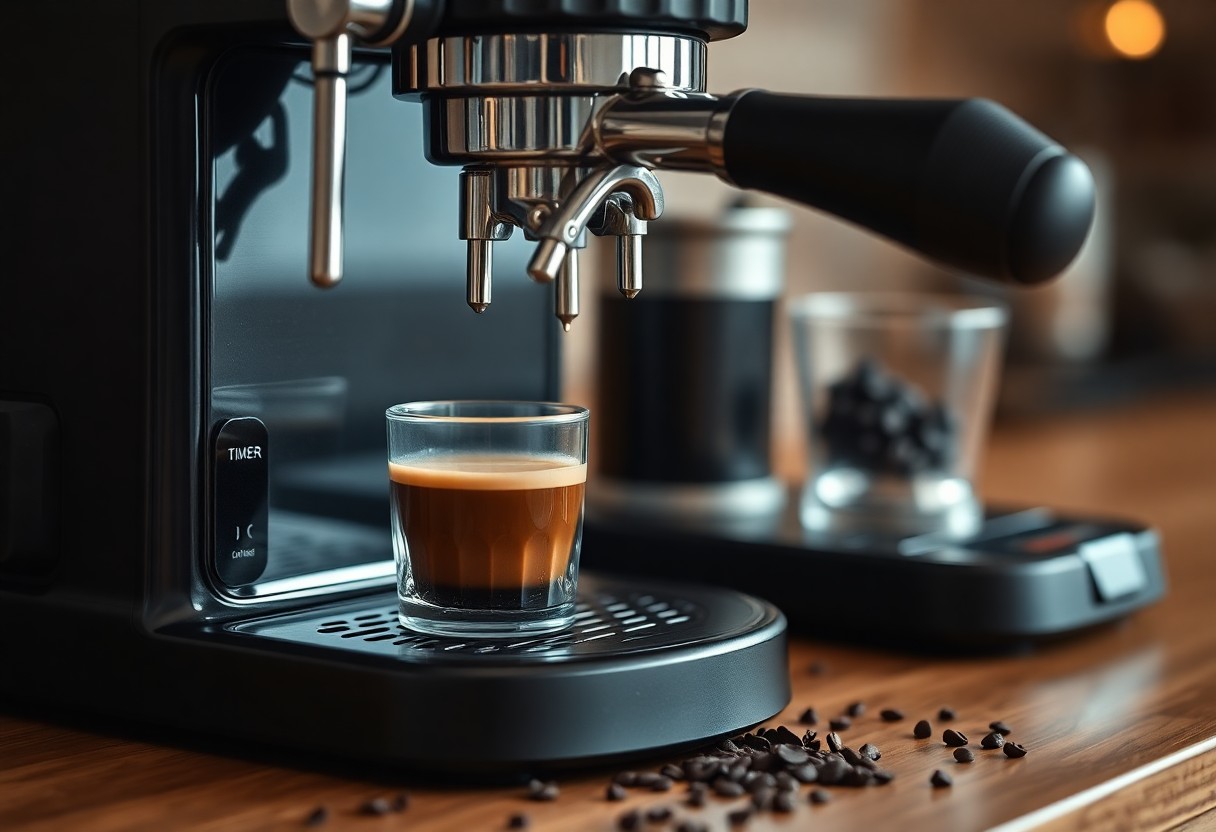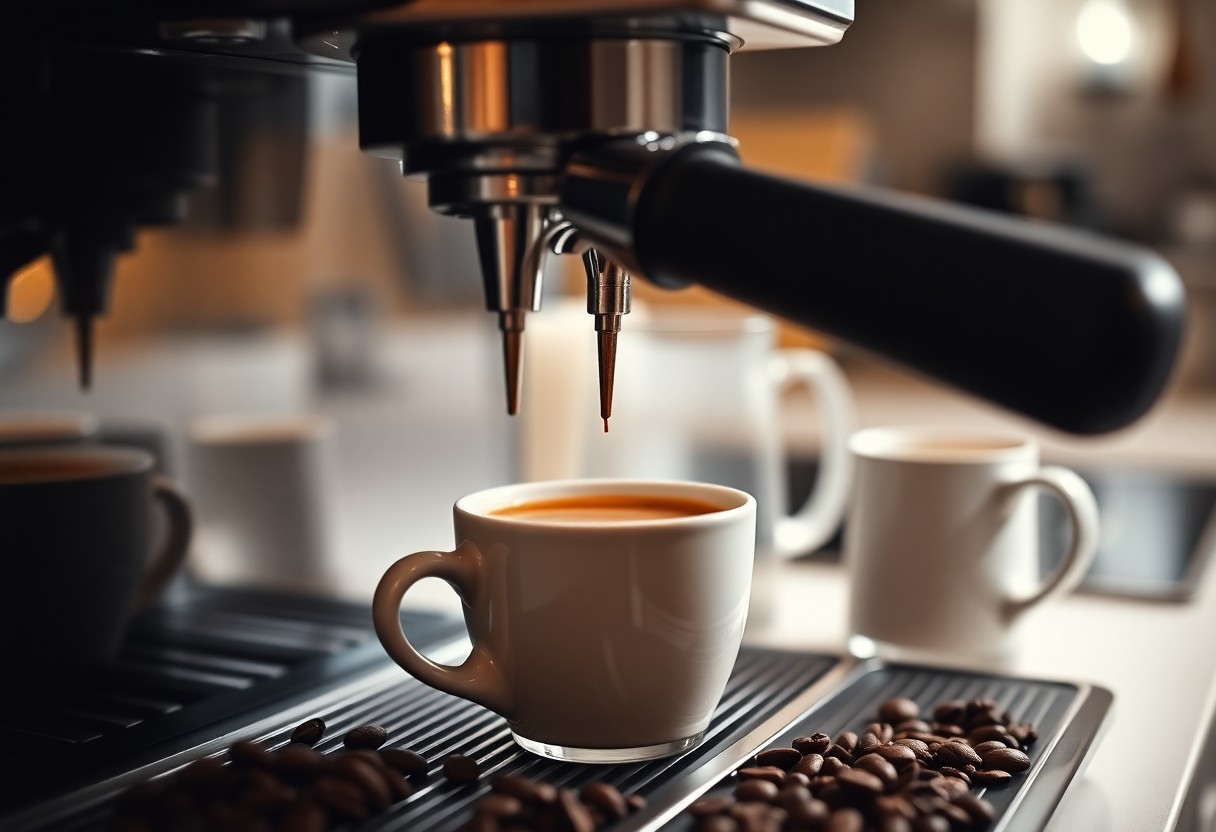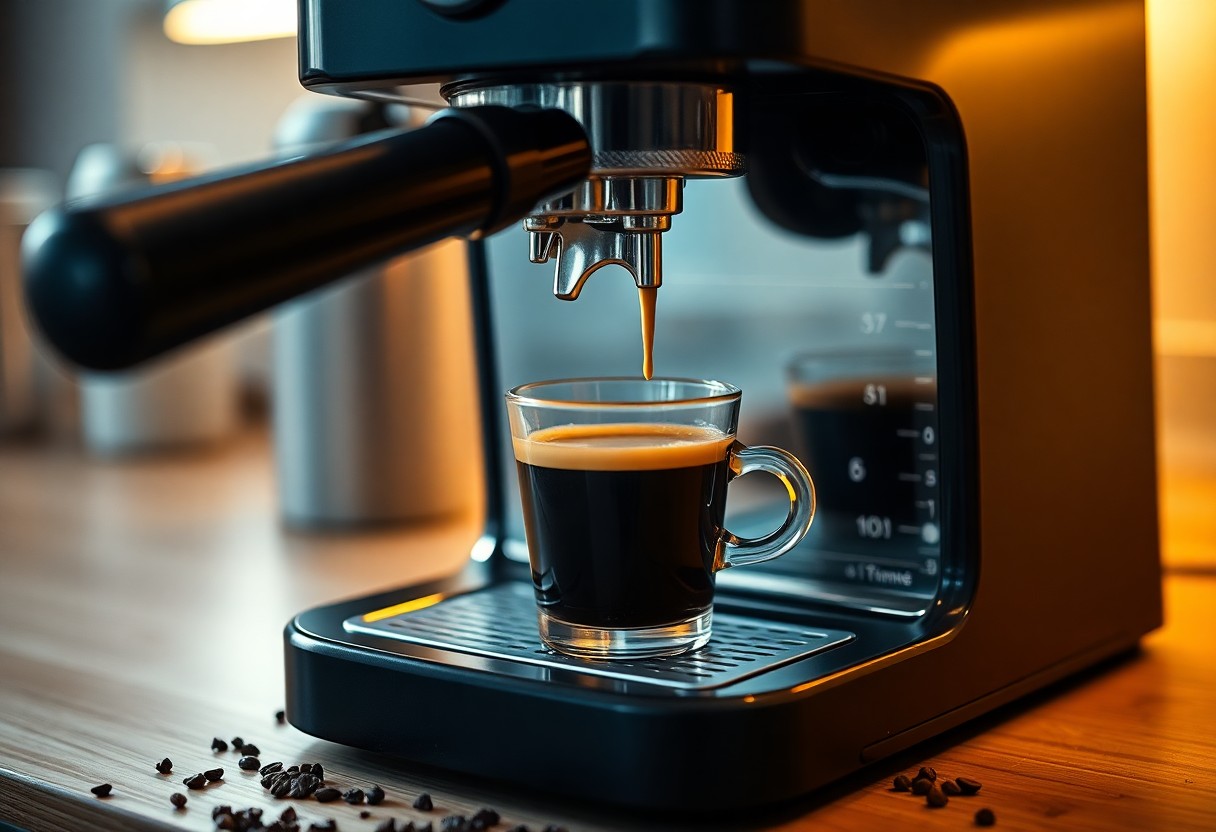Latte lovers, if you’re yearning for a flavorful espresso shot that won’t disrupt your serene night routine, you’ve come to the right place. In this post, you’ll learn how to master the art of pulling an espresso shot with minimal noise, ensuring both peaceful vibes and a delightful caffeine experience. From choosing the right beans to fine-tuning your equipment, we’ll guide you through every step to enjoy your late-night brew without disturbing the tranquility of your home.

Key Takeaways:
- Choose a finely ground coffee to enhance the extraction process and minimize the need for excessive pressure, which can create noise during the espresso shot pulling.
- Utilize a high-quality espresso machine with a quieter operation or opt for manual brewing methods to achieve a smooth, silent extraction.
- Experiment with different tamping techniques to find the optimal pressure that allows for a balanced extraction while reducing the chances of audible leaks or hissing sounds.
The Art of Silencing Your Machine
Mastering the art of quiet brewing elevates your late-night espresso game. Preparing a ‘silent’ shot requires more than just your typical techniques; it’s about fine-tuning both your approach and equipment to minimize noise without compromising the flavor. Armed with some tips and adjustments, you can easily enjoy your favorite brew without waking the entire household.
Selecting the Right Espresso Equipment
Your choice of equipment significantly impacts noise levels during brewing. Opt for high-quality, low-noise machines specifically designed for quiet operation. Models with modified or insulated components, such as those featuring soundproofing materials or a quieter pump, provide an optimal silent brewing experience. A manual lever machine might also be an excellent choice, as it often operates with less mechanical noise.
Modifying Your Setup for Quiet Brewing
To create a more peaceful espresso environment, consider strategic adjustments to your setup. Placing your espresso machine on a vibration-dampening mat minimizes noise transfer to surrounding surfaces. Additionally, using a grind-on-demand grinder allows for better control of grinding sound, whereas investing in lower rpm grinders helps reduce the sound of grinding coffee. Playing around with the settings of both the grinder and the machine can also lead you to your ideal quiet brewing configuration.
Experimenting with your machine’s placement can help cut down on noise significantly. Move your espresso machine away from hard surfaces; placing it on a soft surface can lower vibrations. Consider adding dense mats or foam under your grinder and machine to absorb sound. Bouncing off walls also amplifies noise, so positioning your setup in a corner or away from echo-prone areas can yield better results. With these modifications and a touch of creativity, you’ll achieve a serene atmosphere while enjoying delicious espresso.
Creating the Perfect Coffee Blend
Crafting a delightful espresso blend requires careful selection and pairing of beans. Aim for a harmonious balance of flavors that complements your late-night cravings. Experiment with blends that feature sweeter profiles, like caramel or chocolate notes, to create a smooth, approachable cup. Consider varying the roast levels to achieve complexity; a mix of light and dark roasts often yields a rich, satisfying flavor. Take time to taste-test various combinations, allowing you to fine-tune your blend until it perfectly suits your midnight mood.
Choosing Beans for Nighttime Brews
Selecting the right beans is important for a successful nighttime brew. Look for low-acid varieties that won’t keep you awake with acidity-induced jitters. Beans from South America, especially Brazil, often deliver a smooth cup with chocolatey undertones, making them perfect for late-night sipping. Additionally, consider blends that contain decaffeinated beans to lessen the impact on your sleep while still enjoying the deep, rich flavors you crave.
Grinding Techniques for Flavor and Noise Reduction
Your grinding technique plays a significant role in both flavor extraction and minimizing noise. Choosing the right grinder can make all the difference; a burr grinder not only provides a consistent grind size for optimal extraction but also operates much more quietly than blade grinders. Grinding your beans just before brewing can enhance freshness while reducing the risk of waking the household. For a truly silent operation, consider a hand grinder, which offers control over grind size and operates whisper-quiet.
Focusing on grind size and consistency enhances your espresso flavor while minimizing noise levels. A finer grind extracts flavors more effectively but can create more noise when ground. Aim for a slightly coarser grind just under espresso levels if noise is a significant concern. Additionally, grinding in short bursts instead of continuously can help you control the sound while achieving an even consistency. Implementing a rubber mat beneath your grinder can further dampen vibrations, making your late-night espresso ritual a peaceful experience.
Mastering the Brewing Process
The path to a perfect silent espresso shot lies in the details of the brewing process. Key elements include grinding with precision, dosing accurately, and timing your extraction effectively. Each aspect must be finely tuned to achieve a rich, smooth shot without disrupting your peace. It requires practice and patience but will ultimately reward you with a consistent and delicious espresso experience, even in the quiet hours of the night.
Dialing in Your Grind Size and Dose
Finding the ideal grind size and dose significantly impacts your espresso’s flavor and strength. A fine grind usually complements espresso brewing, while a dose of 18-20 grams is often ideal. Experiment with slight adjustments; too coarse can result in sour flavors, while too fine may lead to over-extraction bitterness. It’s a delicate balance, but honing in on these factors can elevate your late-night coffee to an art form.
Timing: Finding the Sweet Spot for Extraction
Extraction timing is vital to pulling the perfect espresso shot. Generally, aim for an extraction time of 25-30 seconds. Start your timer as soon as you initiate the brew. Look for a steady, thin stream resembling warm honey; this signifies that your espresso is extracting at the right pace. If it runs too quickly, adjust your grind to be finer, and if it drips slowly, try coarser grounds to avoid over-extraction.
Successful timing hinges on observation and adjustment. For instance, an espresso that extracts too fast could be due to an overly coarse grind or insufficient coffee dose. Conversely, if your shot takes longer than 35 seconds, a finer grind or higher dose should be explored. Regularly testing these variables ensures you discover your unique sweet spot, allowing you to craft those perfect silent shots that satisfy your coffee cravings without waking the household.

Essential Milk Techniques: Frothing Silently
Your milk frothing technique can significantly impact the overall experience of your late-night espresso. The goal is to achieve that luxurious microfoam without producing unnecessary noise that might disturb your peaceful environment. Subtle movements and mindful equipment choices make a difference, allowing you to enjoy creamy milk without the loud hissing and spluttering. Focusing on these methods not only respects the tranquility of your setting but also elevates your coffee-making skills to an art form.
Quiet Frothing Alternatives
Consider using a hand whisk or a French press for quieter frothing alternatives. A handheld frother, designed for low decibel output, can efficiently create foam without the traditional steam wand’s noise. Experimenting with temperature and technique through these tools allows you to achieve optimal milk texture while maintaining peace in the night.
Achieving Creamy Texture without Disturbance
Silently frothing milk while achieving a creamy texture relies on slower, deliberate movements to create microfoam. Start with cold milk; the colder the milk, the longer it takes to froth, giving you better control over the frothing process. Use a French press by gently pumping the plunger up and down, which incorporates air without disruptive sounds. This method takes a bit longer, but results in a smooth, velvety foam ideal for your nighttime espresso.
For more precise control, heat your milk separately in a small pot, achieving temperatures between 150°F and 160°F. Once heated, pour it into your French press and gently pump. This maintains a soft sound while promoting a silky finish, perfect for lattes or cappuccinos. The slower you go, the better the texture; your aim is to create the ideal consistency while being mindful of your surroundings. This balanced approach ensures your late-night coffee ritual remains enjoyable without excess noise.
Creating the Ultimate Late-Night Ambience
The right ambience transforms your late-night espresso experience into a soothing ritual. Pair dim lighting with soft background music for a relaxed vibe that allows you to enjoy your coffee without distraction. Consider incorporating elements that engage your senses, from comfortable seating arrangements to tranquil decor, creating the ideal environment for savoring that ‘silent’ shot.
Recommended Lighting and Settings
Opt for warm, low-light sources like table lamps or fairy lights that create an inviting glow while keeping the atmosphere cozy and intimate. Use light dimmers or candles to control brightness, allowing you to set the perfect mood. Avoid harsh overhead lighting, as it can disrupt the tranquility you seek.
The Role of Aroma in Enhancing the Experience
Aroma plays a vital role in your late-night coffee ritual, elevating your overall experience. The rich scent of freshly ground beans can stimulate your senses, making each sip more enjoyable. Engaging your olfactory senses not only enhances flavor perception but also contributes to relaxation, encouraging you to savor your espresso at leisure.
Your environment can significantly amplify the impact of aroma. As you brew your espresso, the smell of freshly roasted beans will evoke warmth and comfort, instantly transporting you to a café vibe. Pair that with aromas from comforting nighttime snacks, like chocolate or warm spices, and your senses will be treated to a full experience. Explore different beans, enhancing their unique scents through various brewing methods, and find what resonates most with you for a personalized touch.
Conclusion
So, by following these steps, you can master the art of pulling a ‘silent’ espresso shot for your late-night coffee cravings. By selecting the right coffee beans, adjusting your grind size, and focusing on your tamping technique, you ensure a smooth extraction without any disruptive sounds. This allows you to enjoy your espresso in a serene environment, perfect for quiet nights of productivity or relaxation. With practice, you’ll be able to savor delicious espresso without the noise, making it an enjoyable experience for you and anyone else around.
FAQ
Q: What does it mean to pull a ‘silent’ espresso shot?
A: A ‘silent’ espresso shot refers to the process of brewing espresso with minimal noise, which can be particularly desirable for late-night coffee lovers looking to enjoy their beverage without disturbing others. This can be achieved by employing techniques that prioritize a gentle extraction and using equipment that minimizes sound during the brewing process.
Q: What equipment do I need for pulling a silent espresso shot?
A: To pull a ‘silent’ espresso shot, you will need a high-quality espresso machine that has a reputation for quieter operation. Additionally, a good burr grinder is necessary to ensure consistent grind sizes without producing excessive noise. Choosing a portafilter with a solid fit and a well-engineered tamper can also help reduce vibrations and noise during the brewing process.
Q: What are the key techniques to ensure a quiet extraction?
A: To achieve a quiet extraction, focus on a few key techniques. First, use a medium to fine grind size ensuring that the coffee is uniformly ground for even extraction. Additionally, apply a gentle and even tamp to avoid excessive pressure that can cause noise during the brew. Lastly, consider lowering the pump pressure if your machine allows, as higher pressure can lead to more noisy vibrations.
Q: How can I serve my silent espresso without making noise?
A: To serve your silent espresso quietly, pre-warm your cup to reduce the chances of cracking sounds and to keep your drink at the desired temperature. When pouring, use a slow, steady hand to minimize splashing. Opt for cups with thicker walls or a soft finish, which can absorb sound better compared to thin ceramic cups.
Q: Are there any specific coffee bean recommendations for night-time espresso shots?
A: Yes, for late-night espresso shots, consider selecting beans with lower caffeine content, such as a decaf option or a blend specifically formulated for smoothness and complexity. This way, you can enjoy the rich flavors of espresso without the high caffeine buzz that may interfere with sleep. Additionally, look for coffee beans with tasting notes that are mellow or sweet to enhance your late-night experience.
